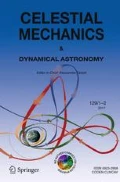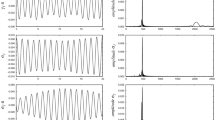Abstract
We present here the first numerical results of our analytical theory of an artificial satellite of the Moon. The perturbation method used is the Lie Transform for averaging the Hamiltonian of the problem, in canonical variables: short-period terms (linked to l, the mean anomaly) are eliminated first. We achieved a quite complete averaged model with the main four perturbations, which are: the synchronous rotation of the Moon (rate
 ), the oblateness J
2 of the Moon, the triaxiality C
22 of the Moon (
\(C_{22} \approx J_2/10\)) and the major third body effect of the Earth (ELP2000). The solution is developed in powers of small factors linked to these perturbations up to second-order; the initial perturbations being sorted (
), the oblateness J
2 of the Moon, the triaxiality C
22 of the Moon (
\(C_{22} \approx J_2/10\)) and the major third body effect of the Earth (ELP2000). The solution is developed in powers of small factors linked to these perturbations up to second-order; the initial perturbations being sorted ( is first-order while the others are second-order). The results are obtained in a closed form, without any series developments in eccentricity nor inclination, so the solution apply for a wide range of values. Numerical integrations are performed in order to validate our analytical theory. The effect of each perturbation is presented progressively and separately as far as possible, in order to achieve a better understanding of the underlying mechanisms. We also highlight the important fact that it is necessary to adapt the initial conditions from averaged to osculating values in order to validate our averaged model dedicated to mission analysis purposes.
is first-order while the others are second-order). The results are obtained in a closed form, without any series developments in eccentricity nor inclination, so the solution apply for a wide range of values. Numerical integrations are performed in order to validate our analytical theory. The effect of each perturbation is presented progressively and separately as far as possible, in order to achieve a better understanding of the underlying mechanisms. We also highlight the important fact that it is necessary to adapt the initial conditions from averaged to osculating values in order to validate our averaged model dedicated to mission analysis purposes.
Similar content being viewed by others
References
Brouwer D. (1959). Solution of the problem of artificial satellite theory without air drag. Astron. J. 64:378–397
Chapront-Touzé, M., Chapront, J.: Lunar Tables and Programs 4000 BC to AD 8000. Willmann- Bell. (1991)
De Saedeleer, B., Henrard, J.: Orbit of a lunar artificial satellite: analytical theory of perturbations. IAU Colloq. 196: Transits of Venus: New Views of the Solar System and Galaxy. pp. 254–262 (2005)
De Saedeleer, B., Henrard, J.: The combined effect of J 2 and C 22 on the critical inclination of a lunar orbiter’. Adv. Space Res. 37(1): 80–87 (2006). The Moon and Near-Earth Objects. Also available as http://dx.doi.org/10.1016/j.asr.2005.06.052
De Saedeleer, B.: Analytical theory of an artificial satellite of the Moon. In: Belbruno, E., Gurfil, P. (eds.) Astrodynamics, Space Missions, and Chaos, of the Annals of the New York Academy of Sciences. Proceedings of the Conference New Trends in Astrodynamics and Applications, January 20-22, 2003, Vol. 1017, pp. 434–449. Washington (2004)
De Saedeleer B. (2005). Complete zonal problem of the artificial satellite: generic compact analytic first order in closed form. Celest. Mech. Dynam. Astron. 91:239–268
Deprit A. (1969). Canonical transformations depending on a small parameter. Celest. Mech. 1:12–30
Henrard, J.: The algorithm of the inverse for Lie transform. In: Szebehely, V., Tapley, B. (eds.) ASSL: Recent Advances in Dynamical Astronomy, Vol. 39, pp. 248–257. Dordrecht (1973)
Jefferys W. (1971). Automated, closed form integration of formulas in elliptic motion. Celest. Mech. 3:390–394
Jupp A. (1988). The critical inclination problem: 30 years of progress. Celest. Mech. 43:127–138
Knežević Z., Milani A. (1995). Perturbation theory for low satellites: an application. Bull. Astron. Belgrade 152:35–48
Knežević Z., Milani A. (1998). Orbit maintenance of a lunar polar orbiter. Planet. Space Sci. 46:1605–1611
Konopliv, A. S., Sjogren, W.L., Wimberly, R.N., Cook, R.A., Vijayaraghavan, A.: A high resolution lunar gravity field and predicted orbit behavior. In Advances in the Astronautical Sciences, Astrodynamics (AAS/AIAA Astrodynamics Specialist Conference, Pap. # AAS 93–622, Victoria, B.C.), Vol. 85, pp. 1275–1295 (1993)
Kozai Y. (1962). Second-order solution of artificial satellite theory without air drag. Astron. J. 67:446–461
Liu L., Wang X. (2000). On the orbital lifetime of high-altitude satellites. Chinese Astron, Astrophys. 24:284–288
Milani, A., Knežević, Z.: Selenocentric proper elements: A tool for lunar satellite mission analysis. Final Report of a study conducted for ESA, ESTEC, Noordwijk (1995)
Oesterwinter C. (1970). The motion of a lunar satellite. Celest. Mech. 1:368–436
Press W.H., Teukolsky S.A., Vetterling W.T., Flannery B.P. (1986). Numerical Recipes in Fortran 77—The Art of Scientific Computing. Cambridge University Press, Cambridge
Roy A. (1968). The theory of the motion of an artificial lunar satellite I. Development of the disturbing function. Icarus 9:82–132
Shniad H. (1970). The equivalence of von Zeipel mappings and Lie transforms. Celest. Mech. 2:114–120
Steichen D. (1998a). An averaging method to study the motion of lunar artificial satellites—I: Disturbing function. Celest. Mech. Dynam. Astron. 68:205–224
Steichen D. (1998b). An averaging method to study the motion of lunar artificial satellites—II: Averaging and applications. Celest. Mech. Dynam. Astron. 68:225–247
Szebehely V. (1989). Adventures in Celestial Mechanics. University of Texas Press, Texas
Author information
Authors and Affiliations
Corresponding author
Rights and permissions
About this article
Cite this article
De Saedeleer, B. Analytical theory of a lunar artificial satellite with third body perturbations. Celestial Mech Dyn Astr 95, 407–423 (2006). https://doi.org/10.1007/s10569-006-9029-6
Received:
Revised:
Accepted:
Published:
Issue Date:
DOI: https://doi.org/10.1007/s10569-006-9029-6




